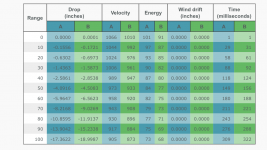Disclaimers/info:
After shooting four 5-shot groups of each at 50 yards and the same at 100 yards, I noticed the following:
For both the Standard + and Rifle Match, SK's site lists a 7" drop at 100yds if you're zeroed at 50yds (like I was.) The Standard + drop was almost exactly that at just a sniff over 7". Do the math then... the Rifle Match was around only a 6" drop. Hmm...
I also find it really strange that the POI drop gap wasn't really there at 50 yards, but became super apparent at 100 yards. That doesn't make sense to my brain.
Finally, I'll throw in here that although I'm fairly new, I feel like I'm a decent enough shooter simply because there isn't much variance in my groups' sizes and POI for each ammo I test, and I've shot a few hundred rounds through this thing by now as I've tested around 6 ammo types so far. (By the way, had some great success with SK Flatnose Match. In fact, the 2nd time I took my rifle out, I pulled off a 0.12" CTC group at 50yds. My avg of 6 groups with that stuff was right around 1/2 MOA. I'm happy with that!)
Anyway, just hoping someone with way more knowledge than me could possibly chime in and educate me. Maybe my expectations are off. Maybe it's me. Thanks!
- I'm new to precision shooting
- I have a CZ 457 Pro Varmint w/ an Athlon Optics Argos BTR Gen2 6-24X50
- I've been ammo testing (5 shot groups) off a sled at a range w/ solid benches and tall earthen wind barriers (I still only test when there's barely any wind)
- I use the Range Buddy app to measure my groups
After shooting four 5-shot groups of each at 50 yards and the same at 100 yards, I noticed the following:
- On average, the Rifle Match groups' POI was only 0.1" higher than Standard+'s at 50 yds, but a full 1.1" higher than Standard+'s at 100yds. (And it wasn't just the POI's average either, as the POI difference between ammo types was fairly consistent each time. At 100 yds, there was only about a 0.1" POI variation between each group of the same ammo type.)
For both the Standard + and Rifle Match, SK's site lists a 7" drop at 100yds if you're zeroed at 50yds (like I was.) The Standard + drop was almost exactly that at just a sniff over 7". Do the math then... the Rifle Match was around only a 6" drop. Hmm...
I also find it really strange that the POI drop gap wasn't really there at 50 yards, but became super apparent at 100 yards. That doesn't make sense to my brain.
Finally, I'll throw in here that although I'm fairly new, I feel like I'm a decent enough shooter simply because there isn't much variance in my groups' sizes and POI for each ammo I test, and I've shot a few hundred rounds through this thing by now as I've tested around 6 ammo types so far. (By the way, had some great success with SK Flatnose Match. In fact, the 2nd time I took my rifle out, I pulled off a 0.12" CTC group at 50yds. My avg of 6 groups with that stuff was right around 1/2 MOA. I'm happy with that!)
Anyway, just hoping someone with way more knowledge than me could possibly chime in and educate me. Maybe my expectations are off. Maybe it's me. Thanks!
Last edited:



